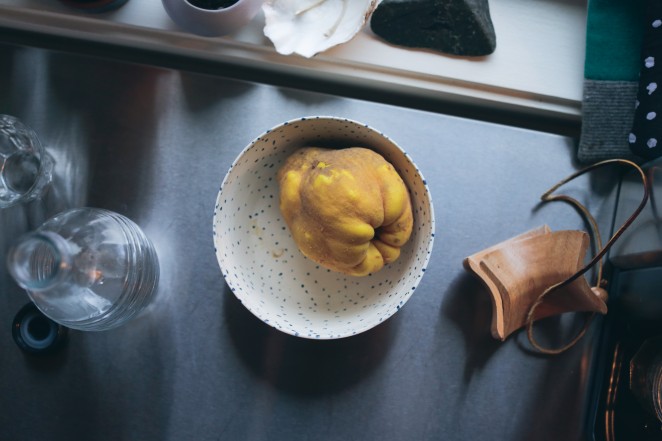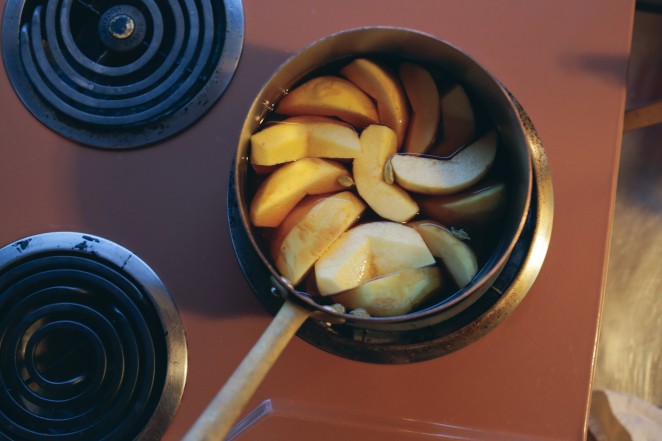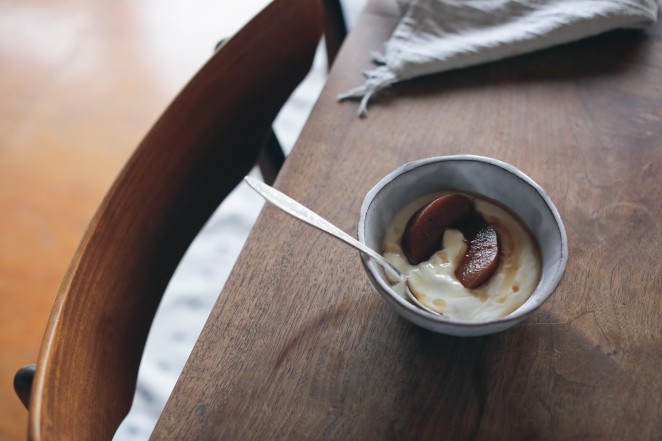Tag: publishing
On esoteric fruit
I first tasted quince the first time I had dinner with my first editor, an exceedingly kind, thoughtful woman of whom I nonetheless was terrified, because she was very New York Publishing World, and because she was my first editor. She had let me choose the restaurant, which only ratcheted up the stakes. I’m surprised that I don’t remember what I wore, because I surely would have labored over the decision with a degree of care most commonly seen among people handling live explosives. The evening went better than I had expected: she told a funny story about her cat and gracefully ignored my elaborate, enthusiastic mispronunciation of the white wine she’d ordered. And when we arrived at dessert, she opened the menu and beamed. “Quince!” she nearly cheered, “I’ll have the quince.”
What arrived was a martini glass – I think? though sometimes I also think my memory is garbage? – containing a scoop of housemade ice cream topped with small, pink, mathematically perfect cubes of what I now know to be poached quince, and on top of that, crumbly nubs of ginger streusel. She spooned up a bite, and as she chewed, her eyelids fluttered. Then she nudged the glass across the table to me.

Quince is an esoteric fruit, hard to find and, once you’ve found it, difficult to subdue. It’s a member of the same family as apples and pears, and it looks a lot like both, though its flesh is more dense and harder by far. It’s knobby, green when it’s not quite ripe and golden when it is, often covered in grayish-white fuzz, like a peach. It’s too hard and sour to eat raw, like raw rhubarb but worse, and it needs a long, slow cook before it will submit to being eaten. I would not write about quince if it weren’t worth the hassle. It is.
Though I will admit that I have occasionally been guilty of buying one not to eat it, but just to keep it next to the sink and sniff it. Perfume is the best word for what a ripe quince smells like, a little like cooked apples, a little like wine, a little like lemon peel, a lot like flowers. It can fill a room. It’s so potent, it’s its own caricature, a quince-scented Yankee Candle as engineered by Nature herself. As a kid, I loved the smell of gasoline and was always rolling down the window and taking deep breaths while my parents filled the tank – this no doubt explains a lot – but as a mature, responsible adult, I’ve traded the old gasoline habit for a quince on the counter, when seasonally feasible.
That said, if you can find a quince, when you’ve had enough of huffing it, I might recommend that you poach it.

There are lots of ways to eat quince: roasted, cooked down into jam or jelly or the sweet-savory paste called membrillo, grated into an apple pie, baked into a tarte Tatin, and whatnot. I keep meaning to try that tarte Tatin. But mostly, when I come across quince, I poach it. I cook it slowly on the stovetop until it softens into a pool of its own syrup and then eat it the next morning for breakfast, with whole-milk plain yogurt. And then again as a snack around eleven. And then I eat it again later in the day, for dessert, on top of ice cream or a slice of pound cake. Poached quince lasts for a good week in the refrigerator, and the longer it marinates in its poaching syrup, the prettier it gets. If you’ve cooked it in a poaching liquid sweetened with sugar, it will get redder as it sits. If your poaching liquid is sweetened with maple syrup, it’ll go a handsome ruddy brown, the color of a caramelized apple.

Poaching quince doesn’t really require a recipe, but my favorite version comes from a new-ish book called The New Sugar and Spice, by Samantha Seneviratne, who, incidentally, I met once in the summer of 2005 in our mutual friend Amy Leo’s backyard in New Jersey, though I haven’t seen her since. Hi, Sam! I love your book!

Her version is simple and well considered: nothing but water, maple syrup, salt, and six green cardamom pods, cracked open under the side of a knife. Actually, I shouldn’t lie: I was wary of using that full half-dozen pods of cardamom. The flavor of quince is so floral, I don’t like to screw with it. I doesn’t need anything. But Sam was right. Poached quince with maple and cardamom is How I Will Henceforth Do Quince: delicate, fragrant, the flavor of the fruit not covered up but boosted.
Maple-Poached Quince
Adapted from The New Sugar and Spice, by Samantha Seneviratne
In Seattle, I’ve found quince at the farmers’ market in the wintertime, and I venture to guess that Whole Foods or another fancy-ish store might have it, too. I also hear that you can sometimes find it at Asian and Middle Eastern markets.
Oh, and everyone talks about how difficult and treacherous it is to peel a quince, but as long as I use my extremely cheap-and-trusty Y-peeler, it’s no biggie. Muuuuch easier than using a knife.
In a medium saucepan, combine the maple syrup, cardamom pods, salt, and water. Whisk to combine.
Cut one of the quince into 8 wedges. Place one wedge, flat side down, on a cutting board, and use a sharp knife to cut a V-shape in the center, removing the seeds. Repeat with the remaining wedges, placing the prepared wedges in the saucepan as you go. Repeat with the second quince. (You’ll probably note, by the way, that the flesh begins to brown when it’s exposed to air, the way the flesh of an apple does; don’t worry too much, because the discoloration will disappear as the quince cooks.)
Place the saucepan over medium-high heat, and bring to a simmer. Lower the heat to maintain a gentle simmer, and cover the pan loosely with a lid, leaving a small crack for steam to escape. (Since the quince will take a while to cook, you want to keep as much moisture in the pan as possible, but you do want to let a small amount of the liquid evaporate, so that it slowly reduces a bit.) Cook gently until the quince is very tender when pierced with a knife, approximately the texture of a canned pear. This may take as little as 50 minutes or as long as 2 hours, depending on your fruit. (Seneviratne advises that you keep an eye on the pot and add more water if needed to keep the fruit submerged until it’s ready, though mine didn’t come anywhere near needing it.)
When the fruit is tender, remove it carefully from the pan to a bowl or storage container, leaving the liquid behind. Fish out the cardamom pods, and discard them. Raise the heat to medium-high and simmer the poaching liquid briskly, stirring frequently, until it has reduced to about one-third of its original volume and is thickened like syrup. Pour the syrup over the fruit, and allow to cool completely.
Serve the cooled quince in wedges or slice it thickly, and be sure to drizzle it with syrup.
Note: Stored in an airtight container, the cooked quince will keep for up to a week.
Yield: 6 servings
This thing is on

Maybe you will remember a day, more than two years ago now, when I announced that I was writing a new book, and that, if all went according to plan, it would be out in the spring of 2013? And then maybe you will also remember that nothing went according to plan, in ways that were hard and good-but-hard and then great and really, really great, and here we are, with no book, in July of 2013. Maybe you will join me, then, in heaving a giant sigh of relief – more than that: a great wind, a hurricane-force gust – that Delancey is not only done, donedonedone, but that it now has a cover. A cover! This thing is ON. I will tell you…
Read more
